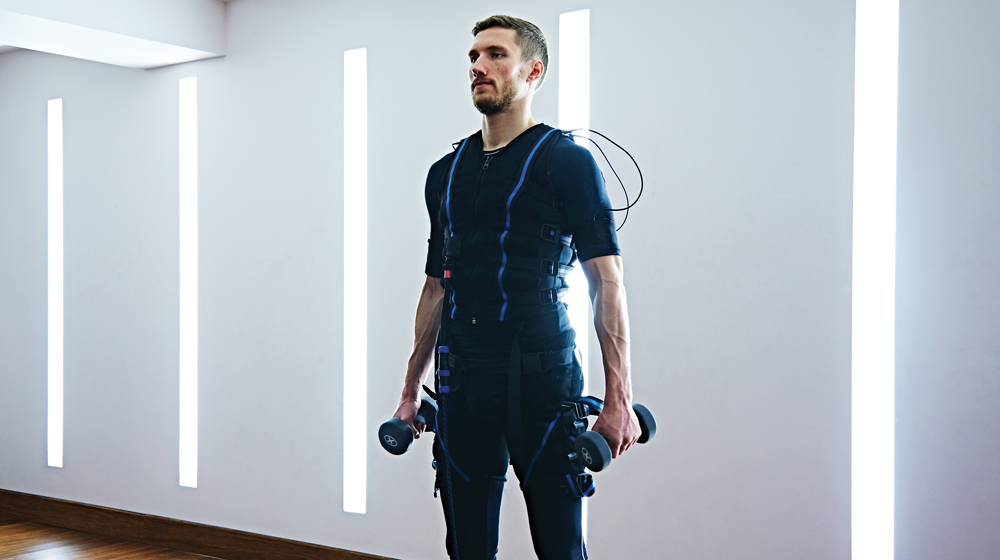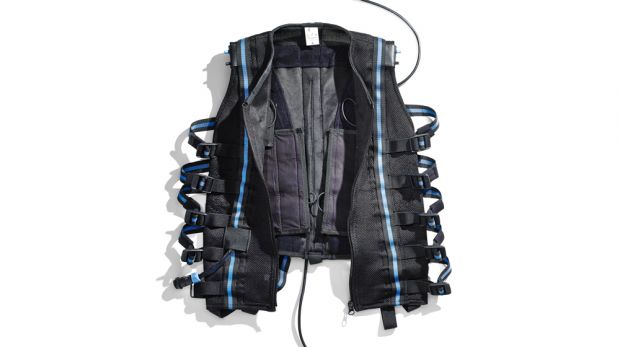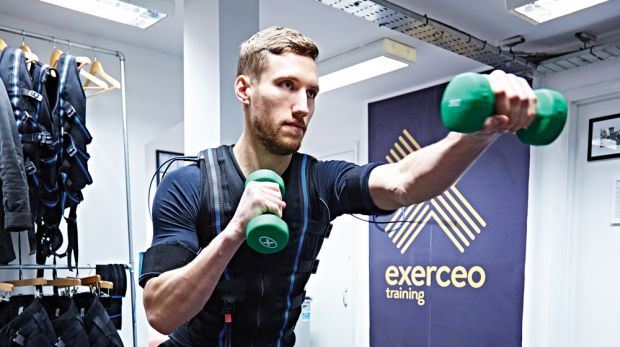Exerceo EMS Training Class: The Legit Electric Muscle Stimulation Programme
Working out while getting your muscles shocked with EMS is supposed to make you stronger, faster. We suit up in the name of science

What is EMS Training?
When anyone mentions electronic muscle stimulation (EMS), the first thing that comes to mind are products marketed with outlandish promises like, “Never Go to the Gym Again!” or “Get Washboard Abs While Watching TV!” If you believe those claims and buy the products, you’re in for an unpleasant shock. However, EMS – where the muscles are stimulated by an electrical current channelled through pads or clothing in contact with the skin – does have beneficial effects: it’s long been used by pro athletes to build strength, with current advocates including Usain Bolt and the German national football team.
Now, classes using the technology are popping up in gyms around the country. Rather than peddling the ludicrous idea that you can simply whack on some pads, twiddle some dials and get shredded while lounging on the sofa, they combine EMS with a HIIT-style session. A Tron-effect suit sends electronic waves through your abs, back, chest, thighs, glutes and biceps while you train, adding extra resistance to movements and enhancing every contraction.
The Method
When we use our muscles voluntarily, our bodies try to conserve as much energy as possible to prolong endurance. This was great for cavemen, who might have needed to chase their dinner for hours at a time. For someone who wants to get as much out of their lunchtime workout as possible? Not so much. But in the 1950s, a Soviet scientist named Dr Yakov Kots presented evidence that applying electricity to muscles overrides that natural energy-retaining mechanism, causing all the motor neurons to fire at once and creating up to 30% more tension in the muscle.
The creators of the Exerceo class – the version of EMS training we are trying – claim that this enhanced muscle engagement, and the extra work required to perform the exercises, makes a 25-minute class as effective as 90 minutes of conventional training. Visible results are expected after just four sessions, with only two sessions needed a week. Can it really be as easy as all that?

The Test
Although instructor Álvaro Suárez comes across as breezy and knowledgeable – he has a sports science degree and years of experience with EMS training – it’s hard not to feel intimidated. After all, this man is going to be administering ever-increasing waves of electricity to my body for the next 25 minutes.
Intimidation is replaced by mild but genuine fear as we’re given skintight shorts and a top to change into. Next, a cold, damp vest and bottoms (to increase conductivity) are put on, strapped up and connected to the EMS machine. It feels weird, but there’s no turning back now.
Classes are done solo or in pairs, and Suárez starts with a gentle warm-up of jogging on the spot. He introduces the electric pulses and… it actually feels pretty good. Like being tickled on the inside. Things ramp up as we move on to jumping jacks followed by squats. All the time Suárez is asking me if it’s OK to crank up the power. Every time, I say yes. Soon, it’s not so pleasant any more.
Get the Coach Newsletter
Sign up for workout ideas, training advice, reviews of the latest gear and more.
As the power of the waves increases, even simple movements become harder to perform. The sensation of the electricity isn’t painful as such, but the way it contorts your body feels totally bizarre. About halfway through the first session I’m doing squats into overhead presses and seriously struggling to extend my arms at the top of the movement. The dumbbells are 2kg.
The final set of exercises are abs-based. You have never felt the pain of a plank until you’ve done it in an Exerceo class. In one way it’s almost easier because your body is electronically manipulated into holding the position, but the vibrating sensation on my lower abs is the most uncomfortable feeling not just of the class, but that I can remember.
The session ends with me lying on my back as my whole body is shocked with gradually reducing intensity. It’s like an electronic massage and a pleasant way to finish.

The Verdict
Having once been one of those fools who hoped to get a six-pack by strapping myself to what was essentially a nine-volt battery (in my defence, it belonged to my brother), I was sceptical of Exerceo at first. Then I looked into the science. Clinical studies from universities around the world have shown that not only does it offer the strength-building benefits of fully engaging muscles as Kots discovered in the 1950s, it can also help with injury rehabilitation and problems such as incontinence and back pain.
Luckily, I don’t suffer from either of those, but Exerceo’s director, Tom Chance, does (back pain, not the other one) and claims that just one class alleviates it for him for up to two weeks. Class regular James Selkirk, 34, has had lower back problems over the years. “Exerceo allows me to work with an intensity I would never normally be able to achieve,” he says. “It’s hugely improved my strength and stability without leaving me in agony afterwards.”
That’s not quite my experience. Agony? The DOMS after my first few sessions was so severe I could barely lift my arms, while the pain in my glutes made me do involuntary old-man grunts when sitting down or standing up. And my body is used to heavy squat sessions, hill sprints and other intense exercise.
The aches lessened as the weeks went by, proving that my previously under-used muscle tissue was getting used to regular activity. After eight Exerceo sessions I can go heavier with overhead presses than I could before the classes, and I now also regularly hold planks for over two minutes (my previous record was 1min 55sec).
So it seems there are benefits to it – at least in the short term. The question you have to answer is whether you want, in effect, to pay to be Tasered for an hour twice a week (Men’s Fitness’s fitness editor Sam Rider also tried it – as seen in the pictures here – and described it as “gentle torture”) when there are plenty of tried-and-tested muscle-building techniques that don’t involve electrically generated pain. Perhaps it’s one for veterans of the more hardcore obstacle races.
The Breakdown
- For any fitness level ✓
- Lose fat ✓
- Build muscle ✕
- Get stronger ✓
- Injury proofing ✓
- Under 30min ✓
- Track progress ✕
- Technique advice ✓
- Available nationwide ✕
- No membership required ✓
Score 7/10
Single Exerceo class £55, trial session £10, packages available, exerceotraining.co.uk
Home EMS Products
Slendertone Abs Toning Belt, £180
Goal A six-pack
Does it deliver? Slap this on your midriff, whack it on full blast and you can get ripped like Arnie while watching Predator on the sofa. Right? Well, some trials show successful results, but we wouldn’t recommend using it as a replacement for training.
Compex SP 8.0, £850
Goal Rehab
Does it deliver? Electrodes make muscles contract to boost blood flow and speed up recovery after exercise, or stem muscle atrophy following injury – all while you sit still. GB snowboarder Jamie Nicholls swears by it after treatment for ruptured knee ligaments.
Kinetik TENS Pain Reliever, £25
Goal Pain relief
Does it deliver? Electrical impulses reduce pain signals to the spinal cord and brain, relieving discomfort and tension – or even stimulate the release of endorphins, the body’s natural painkillers. It’s not a cure, but the NHS has declared it safe for temporary relief.
Relax-A-Cizor
Goal Weight loss
Does it deliver? One from the horror archives. This bit of early wearable tech was supposed to melt body fat away by creating an electrical circuit through your body – but it was banned in 1970 after reports that the device had caused hernias and miscarriages. The US Food and Drug Administration instructed people to destroy existing units to prevent them being paralysed.
Additional words by Dominic Walker
Max was the head of digital content for Men's Fitness which worked alongside Coach between 2015 and 2019.










